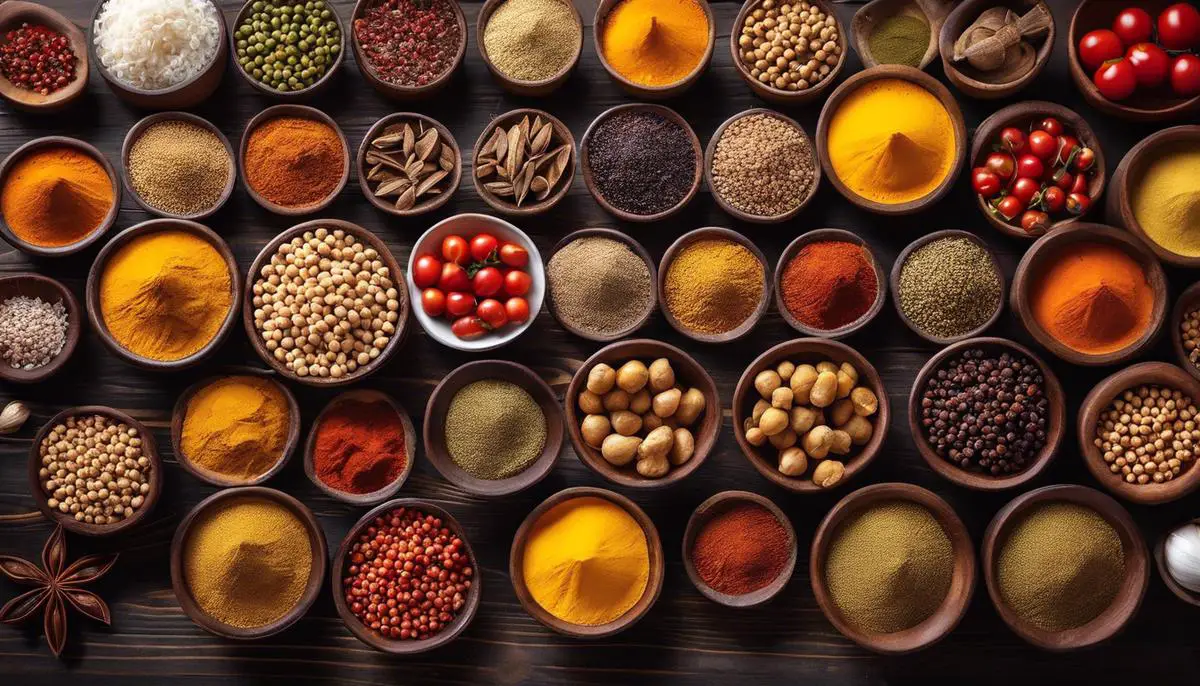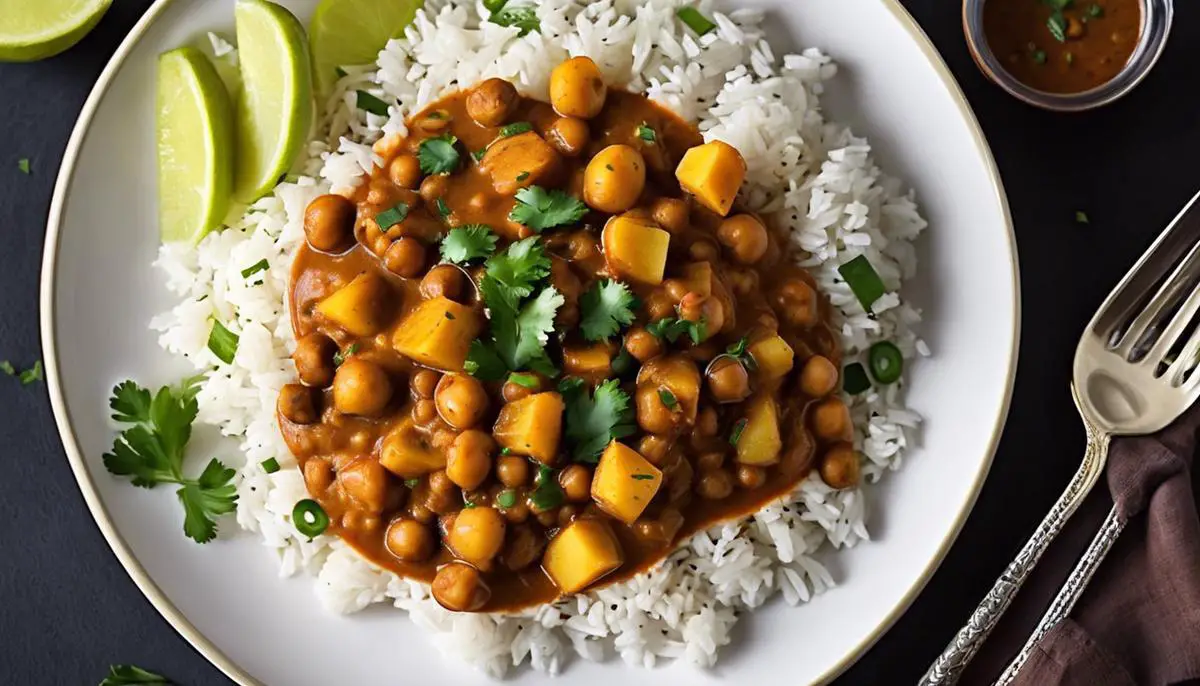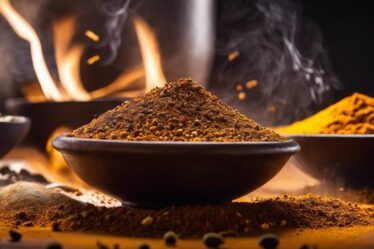
Embark on a culinary journey with the robust and hearty Chana Aloo Curry, paired with the delicate and fragrant Basmati rice—a staple combination that graces culinary traditions with its rich tapestry of flavors and aromas. This essay will serve as a compass to navigate the vibrant landscape of Indian cuisine, guiding you through the art of preparing the essential ingredients for this beloved dish. Step by step, you’ll learn to embrace the rhythm of the kitchen as you master the selection and preparation of chickpeas and potatoes, the fine balance of aromatic spices, and the intricacies of crafting the perfect curry. The dance of frying spices, the symphony of sautéing onions, and the slow simmering of the key components will form the cornerstone of your cooking experience. In tandem, the essay will unlock the secrets to making flawless Basmati rice, from its initial rinse to the crucial moments of boiling and steaming. Prepare to enrich your culinary repertoire with the knowledge you’ll gain from this tour de force of cooking instruction.
Preparing Ingredients
Chana Aloo Curry: Preparing the Heart of the Dish
In the vibrant world of culinary wonders, Chana Aloo Curry stands out with its tantalizing blend of flavors, colors, and textures. It’s the kind of dish that invites you on a journey through the bustling streets of India without ever leaving the comfort of your home kitchen. Preparing the main ingredients for Chana Aloo Curry is like crafting the opening chapter of an epicurean adventure. Let’s dive into the heart of this dish and get those flavors sizzling!
First things first, grab those chickpeas – the Chana in your curry. If you’ve got the time, choose dry chickpeas; soak them in water overnight, and they’ll be plump with potential by the time you’re ready to cook. Lack time? Canned chickpeas are your best friend here. Just give them a good rinse and they’re ready to go – full of convenience and eager to soak up those curry flavors.
Now, let’s talk potatoes – Aloo in Hindi. You want them tender but not falling apart – they’re not looking for a mashed potato destiny here. Go for the gold with Yukon Gold potatoes or keep it classic with Russets. Give them a good scrub, a peel (if that’s your preference), and dice them into bite-sized pieces that will marry well with the chickpeas.
The aromatic base is next on your prep to-do list. Onions, garlic, and ginger – it’s the trinity of flavor that will lay the foundation of your curry. Take it slow and steady. Finely chop your onions, mince that garlic, and grate your ginger. The finer, the better; we’re going for a melodic blend that sings in harmony with every bite.
Now to spice things up! Grab your coriander, cumin, turmeric, garam masala, and chili powder. This is your palette, and you’re the artist. Measure with care or with instinct – depending on your mood – but remember: it’s easier to add more spice than to try and dial it back.
Tomato plays a juicy role in your curry. Opt for fresh, ripe ones, chopped, or take a shortcut with a can of diced tomatoes – no judgment here. They’re ready to jump into the pot and add a burst of color and acidity that’ll bring this dish to life.
Last of all, don’t forget the liquid love. Water is fine, but why not deepen that flavor profile with vegetable broth? It’s all about layering flavors to create a dish that’s rich in character.
You’ve prepared the stars of the show — now let them dance together in the pot, simmering into the warming, comforting Chana Aloo Curry that will wrap you and your guests in a culinary embrace. So, gather around, share the joy, and relish in the unifying power of this splendid dish. Bon appétit!

Cooking Chana Aloo Curry
Now that we’ve marinated our senses in the aromatic world of Chana Aloo Curry, let’s dive into the riveting next steps to ensure that our curry sings with flavors and invites a symphony of compliments from those lucky enough to take a plunge at the dining table.
We begin by setting the stage – heat a generous glug of oil in a thick-bottomed pot, the kind that promises even heat distribution. To this, attentively add your beautifully bloomed spices and let them sizzle, just enough to whisper their secrets into the oil, but be vigilant – no good comes from scorched spices.
Next, sauté your finely chopped onions, stirring them until they’re a golden treasure, emitting a smell that could coax a smile from even the sternest of faces. Patience is key; don’t rush the onions, as they’re the foundation of flavor – the rich, caramelized base from which our curry will rise.
A dash of ginger and a sprinkle of garlic join the fray, both more than just ingredients – they’re the very essence of curry, the soulful notes in our flavor symphony. Dance them around the pan until their rawness mellows and their combined aroma becomes something close to magical.
With our base flavors in harmony, it’s time for the tomatoes to take center stage. Poured into the pot like a sunset, they need time to break down and meld into the melody; simplicity in simmering is what will escalate their taste from solo to symphony.
As the pot bubbles away and our sauce thickens, beckoning with its vivid color, we bring in the stars – tender chickpeas and robust chunks of potatoes. They absorb the flavors like a melody, becoming part of the curry’s tapestry.
Now is the moment to baptize our ingredients with a rich splash of liquid, be it water or stock. It’s vital to add enough to submerge our performers but not too much as to drown them. We want everyone in the curry to have room to move, to dance, and to intertwine. The transformation as the curry simmers is nothing short of alchemy; the chickpeas and potatoes turn tender, every element melds, and the sauce thickens to the point of velvety lushness.
Yes, one could simply stop here and have a decent dish, but let’s not be hasty. A burst of freshness is in order – finely chopped cilantro or a squeeze of lemon juice. These are not mere garnishes but the final flourish to a masterpiece, rounding out the flavors and adding bright high notes to our savory symphony.
Ultimately, a worthy Chana Aloo Curry is not just cooked but coaxed into existence, imbued with the patience and passion it rightly deserves. It belongs on a table surrounded by eager friends, each bite serving as a testament to the joys of kitchen experimentation and the unifying power of a shared meal.
Remember to taste, to enjoy, and let the wonders of this humble yet spectacular dish take your palate on a journey – a delectable reminder of why we venture through the endless wonders of cooking, one spice-laden bite at a time.

Making Perfect Basmati Rice
As the Chana Aloo Curry simmers and fills the kitchen with its intoxicating aroma, attention must be turned to its faithful companion—the Basmati rice.
To create fluffy and non-sticky Basmati rice that sings with perfection, a series of steps need to be meticulously followed.
Before anything, choosing high-quality Basmati rice is crucial. Look for long, slender grains that promise a fragrant and fluffy outcome. Once a reputable source has been secured, measure the desired amount. For a robust Chana Aloo Curry, a good rule of thumb is about a half-cup of rice per person.
Rinsing the rice is the next critical step. Run cold water over the rice until it runs clear. This washes away excess starch and is the secret to achieving that covetable non-sticky texture. Moreover, it ensures the grains will fluff up, rather than clump together, upon cooking.
For those who savor a deeper nuanced flavor, toasting the rice in a little ghee or oil prior to adding water is a game-changer. This process infuses the rice with a nutty essence that complements the bold spices of the curry. However, this step is optional for the minimalist seeking simplicity.
Now, the water to rice ratio is key. A foolproof proportion is one and a half cups of water for every cup of rice. This amount allows the rice enough moisture to cook without becoming soggy.
When it comes to the cooking vessel, a pot with a tight-fitting lid is essential. After adding the rice and water, sprinkle in a pinch of salt for flavor. Bring the water to a rolling boil, and then immediately reduce the heat to the lowest simmer. Cover with the lid, trapping the steam inside. This steaming effect is what will cook the rice evenly and fluff it up beautifully.
Resist all temptation to lift the lid and peek; patience here is as important as the spice blend in your curry. Allow the rice to cook softly for about 15 to 20 minutes, depending on the quantity. Look for the water to be completely absorbed and the rice tender to the touch.
Once fully cooked, remove the pot from the heat but keep the rice covered for an additional 5 minutes. This vital resting period allows the rice to settle, firm up slightly, and become that perfect bowl of fluffy grandeur.
The final flourish involves a fork—yes, a fork. Using such an instrument, gently fluff the rice to separate the grains. This action prevents breaking the rice and ensures that airy texture.
Aromatic, fluffy, and non-sticky Basmati rice is more than just an accompaniment to Chana Aloo Curry; it’s the unsung hero that absorbs every drop of that sumptuous curry and enriches each bite. As the pot unveils the steamy, fragrant treasure, it’s clear that the modest Basmati rice is ready to hold its own against the rich tapestry of flavors in the curry. Bon appétit, or as one might say in the spirit of the dish, खाना का आनंद लें (khana ka anand lein)!

Having simmered in the depths of this flavorful expedition, you now stand equipped with the savvy to transform simple ingredients into an exquisite Chana Aloo Curry, alongside impeccably cooked Basmati rice. The layers of fragrant spices and nuanced techniques are no longer a mystery, but trusted allies in your quest for the perfect meal. As the aromatic steam rises from your creation, it signifies not only a satisfying conclusion to your cooking endeavor but also marks the beginning of your exploration into the vast and delicious world of Indian cuisine. May the skills and insights you’ve gathered serve as a foundation for countless meals to share and savor, as each spoonful of your Chana Aloo Curry and Basmati rice becomes a testament to the journey you have undertaken and the culinary prowess you have achieved. Bon appétit!



